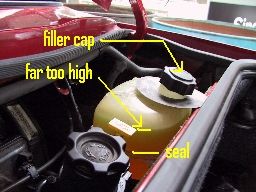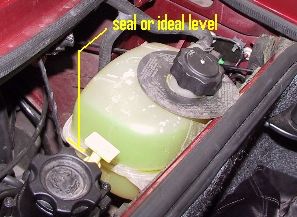D E T A I L S
: COOLING
Several topics to talk about.
Description of the cooling system
Filler caps opens at 1.03
bar
Thermostat opens when coolant temperature is at 86-90°C
Thermostat opens completely when coolant temperature is at 102°C
Fan kicks in at 102°C and stops again at 96°C
The second fan kicks in at 108°C and stops again at 103°C
The fan in the engine bay starts working when the engine bay temperature equals
75°C or higher.
The light on the dashboard is turned on at 90°C.
Bleeding the
cooling circuit
First of all, everyone must
know that bleeding the system (getting all the air out of the system) isn't
an easy job to do, and must be done by following some rules. Let's hope that
the professional technician thinks about it in the same way.
The F has four bleeding
screws (locations) where liquid must be exiting the system until it comes out
without any airbubbles.
- Put the heater control knob on fully heat
- Find the bleeding screws:
* Open the front, at the
top of the nose cone, at the right hand you will find a black, plastic bleeding
screw.
* At the front of the car,
in the neighborhood of the wipers, you will find one.
* You will find another
bleeding screw in the neighborhood of the distributor cap, in the direction
of the throttle body.
* At
the other side of the engine, behind the oil dipstick, near the injectors and
inlet manifold will be a small pipe connected to it with a jubilee clamp. The
hose will go up to the expansion tank.
- Check the correct functioning of the auto bleed valve (the 4th bleeding location/screw).
- Drive the car for a short distance and rebleed the system
Other practical things about the
cooling circuit
A good hint is to check
the coolant level quickly everytime you open the boot. It's even more easily
done when the black plastic pieces above the grill are removed. The coolant
level must be at the same height as the seal of the tank. Some prefer to fill
it a bit more up, in that way that the level is almost 1cm above the seal.
On the pictures shown beneath, the level is far too high, caused by a broken
filler cap. The system must be able to build up a certain pressure. If the pressure
rises, the boiling point of the liquid rises as well. If the fillercap is broken,
the pressure can't rise enough, and the liquid starts booling at aprox. 100°C.


You can easily notice when
the fillercap is dodgy. Remove it from the tank (don't try it when the engine
is hot, you will get hurt by the hot steam escaping from the tank) and turn
in upside down. The small circular, metal 'rivet' must be completely in the
center of the black plastic opening. When it is near the center, get the bike
out and visit your local MG-Rover dealer for a new one.
The newer fillercaps are
also marked with a white dot somewhere on the top of the fillercap. It's more
safe to have one of these than an earlier one.
The radiator is mounted
at the front of the car, this results in cooling pipes running from the rear
of the car to the front. The pipes used for this could get corroded, causing
leaks. An anual check is the least you could do. It's probably not the right
section of the site, but Mike Satur do sell some high quality alloy and powder
coated pipes to resolve this issue (price: £65.00 ex. VAT).

